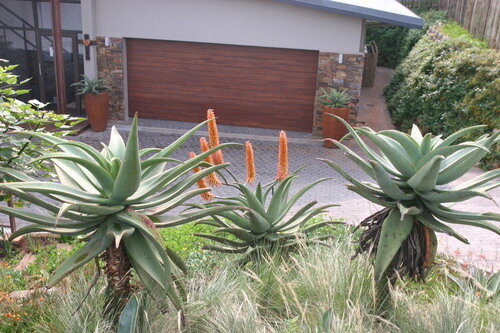What are succulents and why should you be growing South African Succulents in your Garden?
We all love them, right? They’re hardy and can generally withstand even the worst neglect. Succulents are plants that can store water in their stems, leaves or roots, and so enabling the plant to survive in arid conditions. They are thus hardy, water-wise plants, vary in shape and size and are often used in rocky beds and in drier climates. They are extremely versatile and can be used as bed fillers, as landscaping gems, for container landscaping, as paving boundaries, and for contrasting colour and foliage.
Here is our choice of 5 great South African Succulents for your garden
1. Cotyledon orbiculata
This is a plant for all areas. For a pot on the veranda, a hanging basket in the garden, a sunny spot or for shade. This succulent displays beautifully with its large round leaves also called ‘pig’s ears’ because of the red rim around the edge of the leaf. The plan attracts birds and bees and is a statement plant for any water-wise garden. It also gets a beautiful pinkish tubular flower off a long stem, usually in winter from June to August.
This is an easy-to-grow plant and versatile in the garden. It takes well to a rockery but equally to a pot on the patio. If in a flower bed or in a pot, be mindful that it should be well drained. It grows well in sun but also manages in the semi-shade of trees.
2.Portulacaria afra prostrata
Unlike its tall cousin Portulacaria afra, this is a hardy, tough, sprawling ground cover, evergreen succulent, great for water wise gardens. It can reach 2 – 5m in height. It flowers prolifically from late winter through spring with beautiful small pink flowers. The insects love the flowers nectar. The plants leaves can even be added to a salad for a bit of a sour tang.
Also known as the porkbush, this versatile plant can also be used as a clipped hedge or screen cover.
3. Crassula ovata
The queen of all succulents, the Crassula ovata grows easily in the garden but also looks beautiful in containers, both indoors and outdoors. It is used well in pots, rockeries, retaining wall and gravel gardens. This shrub is well-branched although compact, growing up to 3m tall. In winter and spring, it produces beautiful rounded heads of pink flowers, attracting bees, wasps, flies, beetles and butterflies. Flowering is more prolific if planted in full sun. Wasps also enjoy using the plants base to build their nests.
Crassula ovata thrives in full sun or semi-shade and should be fed with plenty of compost and organic or inorganic fertilisers.
4. Delosperma cooperi
This is the most underrated little succulent. Its brilliant green leaves and pretty, tiny white, pink, yellow or peach color flowers light up any corner of the garden and flower over extended periods. It can grow in semi shade beautifully as well as in the full sun. It is a good ground cover filling every bit of soil it’s planted into and requires very little maintenance.
Delosperma although succulent, originate from summer rainfall areas and thus unlike most other succulents, require plenty of water.
5. Kalanchoe sexangularis
This hardy, drought-resistant succulent ‘shrublet’ brings colour to the garden with its wine-red leaves. Planted into a semi shaded area, the leaves will be greener. However, in full sun they will be a beautiful decorative wine-red color. They are a great specimen for any rock garden, or patio. It does not usually exceed a height of 1.5m but has unlimited spread across its width.
Remember to prune older plants every so often to keep them tidy.
6. Aloe zebrina
This small, compact succulent has leaves that are densely clustered in a rosette and are usually marked with oblong whitish spots, giving rise to its Zebra-like name. It flowers sparsely with a pale red tubular flower with many seeds.
Aloe zebrina needs light watering, ensuring sufficient drainage, but it is not a fussy plant and is relatively easy to maintain.
Once you’ve planted these succulents, here are some tips on how to care for them:
Most succulents need very little water, unless otherwise advised. However, even for those that do require water, rather give too little water than too much.
As these plants mostly thrive in arid conditions, place them in bright direct sunlight rather than deep shade. If they are planted in shade, try plant them under a tree that provides breaks of sunshine.
Ensure the soil that you plant your succulents in has good drainage.
If the soil is predominantly clay, use a mixture of compost and riversand to mix in.
Feed your succulents with organic fertiliser or compost when they flower.
If planting your succulents in pots and containers, ensure there is sufficient drainage and used unglazed pots rather than glazed.
Succulents do very well on slopes and can be very useful in binding the soil and preventing erosion.
If you’re looking for additional info on succulents, feel free to contact us.
We based our research for this article on information founds on the SA National Biodiversity Institute (SANBI) website run by PlantzAfrica. There is also a great deal more useful information on these and other South African plants on this website.
Succulent Gift Offering
Who doesn't love succulents? We have a super-unique gift offering - a Succulent Gift Bowl. Why not wow your friends or family with this great gift - delivery is free on the Dolphin Coast. Click here for details.









